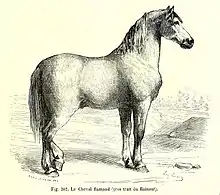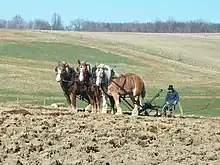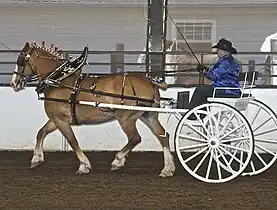Flemish Horse
The Flemish Horse, also known as Belgian Horse (US) or Flanders Horse, Dutch: Vlaams Paard, French: Cheval Flamand, is a Belgian breed of draught horse originating in Flanders, Belgium.
.jpg.webp) | |
| Conservation status | DAD-IS (2023): at risk[1] |
|---|---|
| Other names |
|
| Country of origin | Belgium |
| Distribution | Europe, Northern America |
| Traits | |
| Height |
|
| Colour | usually flaxen chestnut |
| Breed standards | |
_(14578541158).jpg.webp)

It became extinct in the nineteenth century in Europe when it was merged with the Brabant to create the Belgian Draught.[3] From about 1993 it was recreated from some stock kept by Amish people in the United States and Canada.[4][5] A breed association, Het Vlaams Paard (VP), was formed in 1999.[6] In 2005 the breed was officially approved by the Flemish government, and the breed association authorised to manage the stud-book.[7]
The Flemish Horse (Vlaams Paard) should not be confused with the South-African Vlaamperd breed, although both breeds directly translate to Flemish Horse in English. The Vlaamperd derives from the Dutch Friesian Horse, but was shipped from the Flemish port of Antwerp to South-Africa. Hence the confusion in name.[8]
History
Flemish horses became famous in Mediaeval times. They were among the gifts sent by Charlemagne to the Abbasid caliph Haroun ar-Rashid in 807.[9]: 23
In the mid 1700s, the Flemish Horse was the most predominant Belgian draught horse breed. It was a popular heavy war horse from the Low Countries.[10]
Near extinction
In 1886, an official national studbook of Belgian draught horses was established by the "Société Nationale du Cheval de trait Belge", where three categories of Belgian draught horse breeds were distinguished:[3][11]
- Flemish Horse (Vlaamse Paard) from the County of Flanders
- Brabander from the Province of Brabant
- Ardennais (Ardenners) from the Ardennes mountains.
All three regions are in Belgium and all three breeds are Belgian draught horses. The newly formed country of Belgium was removing everything “Flemish” to replace it with a more politically favourable unionised “Belgian”-version.[3] The country was in need of a national symbol for the entire nation, and as a consequence the Flemish Horse breed declined rapidly between 1886 and 1888. In 1888, the Flemish Horse was completely removed from the national studbook-list, due to the big downfall of the breed.[3][11] The Flemish Horse was exported worldwide and in Belgium crossbred within the Brabander to form the Belgian Draught, resulting in only two officially recognised Belgian draught horse breeds in 1888; the Belgian Draught and the Ardennais. Many of the politically unfavourable Flemish Horses were exported to North-America, furthermore many of the Flemish emigrants to North-America brought Flemish Horses along with them.[3] On the 25th of February 1887 the "American Association of Importers and Breeders of Belgian Draft Horses"-studbook was established.[3] The export of Belgian horses included some Brabanders and Ardennais as well, however the North-American Belgian Drafts clearly represent the original Flemish Horse phenotype in their physical and morphological appearance.[4][5][12]
Reviving the breed

The Flemish Horse was exported worldwide during the 19th century, after the independence of Belgium. It was a very popular breed among the Amish in the United States (mostly in Ohio and Indiana) and in Canada,[4] and the Flemish Horse is often referred to as the Belgian Horse or Belgian Draft in North-America. The American Belgian Draft derives from the same original stock, called the Flemish Horse, as part of the European Belgian draft horses, such as the Belgian Draught and Ardennais.[3] The Belgian Draught in Europe has developed differently than the American Belgian Drafts, as in Europe the Flemish Horses were merged with the Brabant, a more heavy built type from Brabant, to create the Belgian Draught.[3] The American version is generally taller and less heavily built, and has a very different distribution of coat colours.[5] Most of the horses known as American Belgian Drafts in North-America are actually the original Flemish Horses that continued to survive in the isolated Amish community and in Canada.[4][5] While the Flemish Horse became nearly extinct in Europe, when they were merged with the Brabant to create the Belgian Draught.[3][12] Unlike the European Belgian Draughts, which are the result of crossbreeding multiple Belgian draught horse breeds, the Flemish Horse is a purebred breed.[13]
Fortunately, the Amish and Canadians kept the original Flemish Horse isolated from other breeds in its purebred shape.[5] From 1989, the Flemish Horse was reintroduced to Flanders, Belgium, and the breed could again be restored to its former glory in its home country.[4][12] Through exchanges between the North-American Flemish Horses and the last few Flemish Horses of breeders in Europe, sufficient genetic diversity was obtained to establish, maintain and improve the breed in a healthy way.[3][12]
Breed recognition
An intensive breeding program followed and in 2005 the studbook VP (Het Vlaams Paard) was recognised by the Belgian government.[5] The Flemish Horse is now recognized as an official breed by the European Union, although, it is an endangered breed.[1] In 2013, the total numbers were about 100 head, with about 35 brood mares and 5 stallions.[14]: 443 However, the amount of Flemish Horses is still continuing to grow and the number of exchanges between European and North-American Flemish Horses is still increasing to this day in order to maintain a healthy and genetically diverse breed.[15]
Characteristics

The Flemish Horse has longer legs, is taller and less heavy built than the Belgian Draught and Ardennais. The neck and head of the Flemish Horse are significantly lighter built than the other two. The colour of the breed is usually chestnut with flaxen manes and tail.[5] Roan, brown or bay colours are also possible in Flemish Horses, but less common. Unlike the other two Belgian draught breeds, the Flemish Horse usually comes with white markings on their legs and face.
The Flemish Horse, like several other draught breeds with similar ancestry to the Belgian Draught, may be affected by junctional epidermolysis bullosa.[16]: 124 Unlike the Belgian Draught, it is not susceptible to chronic progressive lymphoedema.[17]: 260
Gallery
Further reading
References
- Breed data sheet: Vlaamse Paard / Belgium (Horse). Domestic Animal Diversity Information System of the Food and Agriculture Organization of the United Nations. Accessed May 2023.
- Élise Rousseau, Yann Le Bris, Teresa Lavender Fagan (2017). Horses of the World. Princeton: Princeton University Press. ISBN 9780691167206.
- "Het Vlaams Paard vzw - Geschiedenis". www.vlaamspaard.be. Retrieved 3 May 2023.
- "Geschiedenis – Stal Talpe" (in Flemish). Retrieved 3 May 2023.
- "Vlaams paard | Steunpunt Levend Erfgoed". sle.be. Retrieved 3 May 2023.
- Histoire (in French). Het Vlaams Paard. Accessed June 2019.
- Y. Leterme (29 July 2005). 21 Juin 2005 - Arrêté ministériel portant agrément de l'a.s.b.l. "Vlaams Paard" (in French). Le Moniteur Belge. Accessed June 2019.
- lizzie (4 March 2020). "AskHQ: The Vlaamperd". HQ Magazine. Retrieved 3 May 2023.
- Hynderick de Theulegoet (1911). Monographie du cheval de trait belge (in French). Bruxelles: Librairie nationale d'art et d'histoire.
- "Belgian Draft Horse - Brabant Drafthorse: Trekpaard.net". www.trekpaard.net. Retrieved 3 May 2023.
- Goedleven, Edgard (July–August 1991). "HET BELGISCHE TREKPAARD. LEVEND CULTUREEL ERFGOED" (PDF). Stichting Monumenten- en Landschapszorg V.z.w. 10 (4): 11–12.
- "Het Vlaams Paard vzw - Geschiedenis - Eerherstel van het Vlaams Paard". www.vlaamspaard.be. Retrieved 3 May 2023.
- "Het Vlaamse Trekpaard". www.eriktanghe.com. Retrieved 3 May 2023.
- Valerie Porter, Lawrence Alderson, Stephen J.G. Hall, D. Phillip Sponenberg (2016). Mason's World Encyclopedia of Livestock Breeds and Breeding (sixth edition). Wallingford: CABI. ISBN 9781780647944.
- "Toenemende in- en uitvoer van Vlaamse Paarden". Landbouwleven (in Dutch). 20 January 2022. Retrieved 3 May 2023.
- John D. Baird, Lee V. Millon, Susan Dileanis, M. Cecilia T. Penedo, Alexandra Charlesworth, Flavia Spirito, Guerrino Meneguzzi (2003). Junctional epidermolysis bullosa in Belgian draft horses. Proceedings of the American Association of Equine Practitioners 49: 122–126. Archived 26 June 2019.
- Kirsten De Keyser, Steven Janssens, Nadine Buys (2015). Chronic progressive lymphoedema in draught horses. Equine Veterinary Journal 47 (3): 260–266. ISSN 0425-1644. doi:10.1111/evj.122561.
.jpg.webp)


_(cropped).jpg.webp)




.JPG.webp)



_(cropped).jpg.webp)
_(BM_1868%252C1114.287).jpg.webp)
